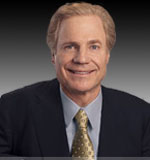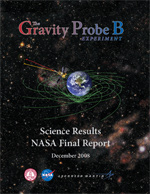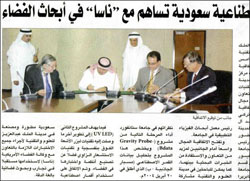MISSION UPDATE — February 16, 2009
PROGRAM STATUS
Observation of Frame-Dragging

Processed data showing geodetic effect
in all four gyroscopes.

Processed data indicating frame-dragging
effect in all four gyroscopes
The latest GP-B results, detailed in the papers and NASA report described below, show substantial improvement over the preliminary results announced at the April 2007 meeting of the American Physical Society (APS). At that time the geodetic effect was measured with a total uncertainty of 1%, but evidence of the frame-dragging effect was inconclusive.
The latest data analysis that includes a model for the "roll-polhode resonance torque" yields a 15% statistical uncertainty for the Frame-Dragging effect. This 15% uncertainty does not include all systematic effects. Click on the thumbnails at right to view these extraordinary results.
The data analysis leading up to this important result proved more subtle than expected. ‘Patch-effect’ anomalies on the gyro rotor and housing have complicated the gyro behavior in two ways:
- A changing polhode path affecting the determination of the gyro scale factor.
- Two larger than expected Newtonian torques.
Put simply, while mechanically both rotor and housing are exceedingly spherical, electrically they are not. Steadily advancing progress, reported to NASA directly and via successive meetings of the SAC, has brought a rather complete understanding of these effects. A turning point came last August with the incorporation of an elegant approach for computing the detailed history of the “roll-polhode resonance” torques discovered a year earlier by Jeff Kolodziejczak of NASA MSFC. The result was a large reduction in previously unexplained discrepancies between the four gyroscopes.
Much further work remains to bring the analysis to completion. To date, limits in computational power have bounded the processing to essentially one point per 97-minute GP-B satellite orbit. The driving period of the roll-polhode resonance torques is at the difference between the 77.5 sec roll period of the spacecraft and a harmonic of the gyroscope polhode period. High-speed computing techniques now in development will lead to more detailed analyses, and allow GP-B to approach the intrinsic limit of the gyro readout.
ISSI Presentations/Publications & Final NASA Science Report
Early last October, five members of our GP-B team presented papers on various aspects of the GP-B data analysis at the International Space Science Institute (ISSI) workshop in Bern, Switzerland on “The Nature of Gravity: Confronting Theory and Experiment in Space.”
The five papers summarize the interim results of the GP-B experiment, as also reported to our GP-B external Science Advisory Committee (SAC) at their 18th meeting on August 29, 2008. Following the ISSI meeting, the papers were submitted for publication in the international, refereed journal, Space Science Reviews. They will be reprinted in a hardcover book in the Space Sciences Series of the ISSI, both to be published by Springer later this year.
The papers, along with an introductory preface, comprise the contents of a document entitled “Gravity Probe B Science Results—NASA Final Report,” now posted on our website. Click on the text link or thumbnail at right to view/download it.
GP-B Funding

Richard Fairbank
We are profoundly honored that in January, 2008 Richard Fairbank (founder, Chairman and CEO of Capital One Financial Services Company and one of the three sons of GP-B co-founder, William Fairbank) made a private donation of $512K to Stanford, specifically to support GP-B’s continuing data analysis work. Fairbank’s generous offer was subsequently matched by both Stanford and NASA. This support carried the program until 30 September 2008. All of us here at GP-B are most grateful to Mr. Fairbank for his generous support.
Discussions begun last summer with Dr. Turki al Saud, Vice President for Research Institutes at the King Abdulaziz City for Science and Technology (KACST) in Saudi Arabia, have led to the creation of an important Stanford-KACST collaboration, with Professor Charbel Farhat of the Stanford Aero-Astro Department as Co-PI for GP-B data analysis. (The photo at right shows the Stanford-KACST collaboration signing last October.)
As part of this agreement, a team of research scientists from KACST will join the Stanford team to help with the data analysis as well as participate in future projects being developed. Additionally, KACST provided funding for GP-B from October 2008 through December 2009. To maximize the benefit to the scientific and engineering community, we plan to make the capstone of the GP-B program a conference on Fundamental Physics and Innovative Engineering in Space, in honor of William Fairbank.
We thank NASA for forty-four years of continued support since issuing the first research Grant NSG-582 to the program in March 1964. The March 2007 "GP-B Post-Flight Analysis—Final Report" contained an extensive history of GP-B and the NASA personnel who guided it. It is appropriate here to express further special thanks to three individuals, the MSFC Manager Mr. Anthony T. Lyons, the HQ Program Scientist for Physics of the Cosmos Dr. Michael H. Salamon, and the HQ Program Executive Dr. Alan P. Smale. Lastly, we are most grateful to the GP-B Science Advisory Committee (SAC) for their continuing advice and support.
LINKS TO OTHER GP-B TOPICS
- GP-B Frequently Asked Questions (FAQ)
- Track the satellite in the sky
- Build a paper model of the GP-B Spacecraft
- Our mailing list—receive GP-B status updates via email
- View a Flash
video of Professor Everitt's 18 May 2006 lecture on GP-B
Note: Both audio-only and video versions of this lecture are also available on the Stanford on iTUNES U Web site. This Web page automatically launches the Apple iTunes program on both Macintosh and Windows computers, with a special Stanford on iTunes U "music store," containing free downloads of Stanford lectures, performances, and events. Francis Everitt's "Testing Einstein in Space" lecture is located in the Science & Technology—Engineering section. People with audio-only iPods can download the version under the Audio tab; people with 5th generation (video) iPods can download the version under the Video tab.
Previous Update | Index of Updates


